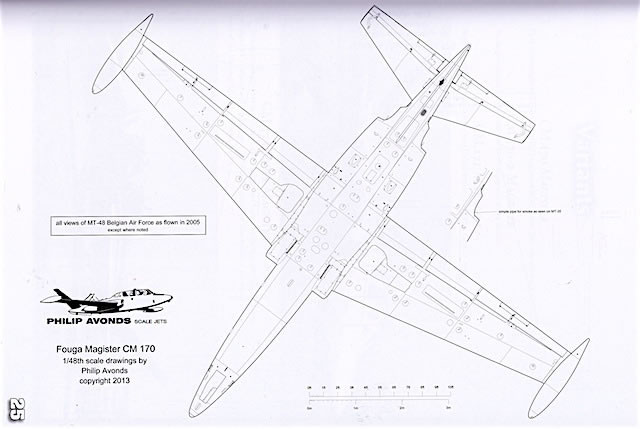S u m m a r y : |
Catalogue Number, Description and ISBN: |
Mushroom Model Publications
Fouga Magister
ISBN:
978-83-63678-38-8
MMP Books
|
Contents & Media: |
Soft cover, 132 pages, A4 format; English text; colour and black and white photographs; colour profiles; black and white plans |
Price: |
GBP £19.99 from MMP Books
or from specialist book and hobby shops. |
Review Type: |
First Look |
Advantages: |
Interesting subject, high quality illustrations and readable text. |
Disadvantages: |
|
Conclusion: |
This book is a great reference for modellers and aviation enthusiasts alike. While its bias is unashamedly technical there is enough background information to put the Magister in context, and some of the 30-plus colour profiles are mouth-watering modelling subjects. Highly recommended. |
Reviewed by Brad Fallen

HyperScale is proudly supported by Squadron
The Fouga Magister is one of the most successful training aircraft ever produced. From 1951 nearly 1,000 Magisters were built in France, Germany, Finland and Israel, with many of these upgraded or reconditioned and then on-sold around the world.

The Magister's affordability and excellent flying characteristics saw it operated by more than 20 air forces and remain in service for over 50 years. This variety of markings makes the Magister a popular modelling subject – good kits are available in 1/72 and 1/48 scales, and there are plenty of decal and other aftermarket options.

If you are modelling the Magister then you’ll want this book by your side. Tine Soetaert uses the A4 format of MMP's White Series to tell the Magister's story – historical and technical – in expansive detail. Chris Sandham-Bailey contributes 35 full-colour profiles, and Philip Avonds full sets of 1/72 and 1/48 plans.
Soetaert breaks her subject up into the following chapters, all of which are accompanied by relevant, high quality colour or black and white photographs:
- Development. Being ignorant of the Magister’s development I was fascinated by its evolution from a series of powered glider prototypes, which had their Turbomeca jet engines mounted He-162 style on the fuselage spine.
- Technical specifications and description. After listing key dimensional and performance statistics, Soetaert describes Magister construction, controls, landing gear, fuel, air conditioning and cabin pressurisation, armament, and the oxygen, electrical, hydraulic and oil systems. Eight pages of Phil Avonds’ plans conclude this section, and will prove helpful for anyone building the Magister in 1/72 or 1/48 scales.
- Variants. Unsurprisingly for an aircraft built for so long in such numbers, there were a number of different sub-types produced, all of which are described in both writing and illustration:
- CM.170 Magister
- CM.170-2 Magister
- CM.171 Makalu
- CM.173 Super Magister
- CM.175 Zephyr
- CM.191
- Fouga 90
- Production. This brief chapter describes some of the challenges in identifying how many Magisters were built and by whom, and is accompanied by photos of various Magister production facilities.
- The Fouga Magister around the world. This chapter is probably the highlight of the book for me, and tells the story of the Magister’s use around the world in a variety of roles and circumstances. A full colour, side profile is included of at least one Magister used by each of the following operators, and some of the schemes are spectacular:
- France
- Belgium
- Germany
- Finland
- Austria
- Katanga
- Cambodia
- Brazil
- Israel
- Algeria
- Morocco
- Bangladesh
- Lebanon
- Cameroon
- Gabon
- Ireland
- Uganda
- Salvador
- Senegal
- Togo
- Biafra
- Democratic Republic of the Congo
- Fouga Magister in detail. This chapter is where – having selected the aircraft you’re modelling in the previous chapter – you will find all the walkaround information you need to complete a detailed model in your chosen scale. Photographs are full colour, high quality and well captioned; some differences between versions are pointed out, and it will pay to keep on top of this if you’re using the photos as a build reference. At over 70 pages, the chapter takes up more than half of the book and is broken down in the following logical sequence:
- Nose
- Front fuselage
- Rear fuselage
- Wings
- Front and rear cockpits (including drawings with instrument location map)
Overall production quality is of the high standard I have come to associate with MMP publications.
This book is a great reference for modellers and aviation enthusiasts interested in the Magister. While its bias is unashamedly technical there is enough background information to put the Magister in its historical context, and some of the 30-plus colour profiles are mouth-watering modelling subjects. Highly recommended.
Highly Recommended.
Thanks to MMP Books for the sample.
All MMP Books are available direct from
the publishers,
who now accept credit cards (Visa, MC, Amex, Switch)
North American
distributors are MMD, Australian distributors are Platypus
Publications. In Europe, the books are available from any good bookshop (via our
UK distributors, Orca). Contact MMP direct in case of difficulties.
Thanks to Roger at MMO Books for
the sample.
Review Copyright © 2016 by Brad Fallen
This Page Created on 20 September, 2016
Last updated
21 September, 2016
Back to HyperScale Main Page
Back to Reviews Page

|
